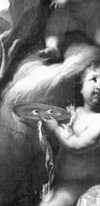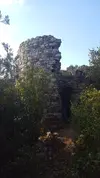Il nobile Huygens vide nel giovane Tidi il degno sostituto di Alessandro Gherardini, un abile e stimato artista del tempo al quale Huygens aveva commissionato nel 1707 un’opera pittorica da collocare nella sua cappella adiacente alla villa della Valle Benedetta. La cappella di Santa Lucia, ovvero il sacellum inferna, come viene denominato dalle streghe durante il sabba, ma questa è un’altra storia...
L’opera commissionata al Gherardini doveva proprio raffigurare Santa Lucia e sarebbe poi stato posizionato sopra il piccolo altare. Purtroppo al Gherardini servirono 7 anni per completare l’opera, infatti fu consegnato nel 1714. Di questo stupendo dipinto voglio postare un particolare molto importante, causa della misteriosa morte di Maria Scolastica Andreoni, come narrai in un post di qualche anno fa, esattamente il 16 marzo del 2018. Nel prossimo post sarò più esaustivo.
Nonostante il dipinto risultò essere di grande pregio, Huygens dovette interrompere la collaborazione con il Gherardini a causa della scarsa disponibilità del pittore, oberato da tantissimi incarichi. Inoltre l’artista era caratterizzato da un carattere che spesso irritava Huygens fino al punto da determinare contrasti che portavano ad un allontanamento fra i due e a numerosi contrasti. Anche sul titolo dell’opera ci furono numerose discussioni. Huygens voleva intitolare il dipinto “l’occhio blu e l’occhio verde”, il Gherardini, che poi ebbe la meglio, lo voleva intitolare “ immacolata concezione con Dio padre, San Giovanni e Santa Lucia”.
Ma torniamo al sodalizio fra Huygens e Pandolfo Tidi, una breve ma intensa collaborazione che durò circa un anno, interrotta bruscamente dalla misteriosa scomparsa di Huygens, avvenuta nel 1717 e camuffata con un falso funerale. Nonostante tutto Pandolfo Tidi riuscì a rispettare i suoi impegni. Gli accordi con lo Huygens, che pagò in anticipo una grossa somma di denaro al Tidi, prevedevano la realizzazione di due dipinti destinati alla chiesa della Valle Benedetta e la costruzione di un oratorio dedicato a Santa Lucia presso la fattoria di Popogna che il Tidi completò nel 1760, assieme ad una fastosa villa, proprio adiacente all’oratorio. Per qualche sconosciuto motivo, il nobile Antonio Huygens voleva che il culto di Santa Lucia venisse tramandato anche in Popogna, un luogo non lontano dalla Valle Benedetta, due realtà unite da una spirale profonda, due luoghi dove il passato ed il presente si fondono per tentare di forgiare il futuro, quel futuro dove un ambizioso diacono voleva specchiarsi senza comprendere che tale specchio era capace di livellare lo spazio-tempo dentro le sue immagini che racchiudono la storia e tutte le leggende, compreso il grande dolore che l’uomo riesce suo malgrado a creare.
(English)
The noble Huygens saw in the young Tidi the worthy replacement for Alessandro Gherardini, a skilled and esteemed artist of the time to whom Huygens had commissioned a pictorial work in 1707 to be placed in his chapel adjacent to the villa in the Valle Benedetta. The chapel of Santa Lucia, or the sacellum inferna, as it is called by witches during the Sabbath, but that's another story...
The work commissioned from Gherardini really had to depict Saint Lucia and would then be placed above the small altar. Unfortunately it took Gherardini 7 years to complete the work, in fact it was delivered in 1714. I want to post a very important detail of this stupendous painting, the cause of the mysterious death of Maria Scolastica Andreoni, as I related in a post a few years ago, exactly the March 16, 2018. In the next post I will be more exhaustive.
Although the painting turned out to be of great value, Huygens had to interrupt his collaboration with Gherardini due to the lack of availability of the painter, overburdened by many assignments. Furthermore, the artist was characterized by a character that often irritated Huygens to the point of determining contrasts that led to a separation between the two and to numerous contrasts. There were also numerous discussions on the title of the work. Huygens wanted to entitle the painting "the blue eye and the green eye", Gherardini, who then prevailed, wanted to entitle it "Immaculate Conception with God the Father, Saint John and Saint Lucia".
But let's go back to the partnership between Huygens and Pandolfo Tidi, a brief but intense collaboration that lasted about a year, abruptly interrupted by the mysterious disappearance of Huygens, which took place in 1717 and disguised with a fake funeral. In spite of everything, Pandolfo Tidi managed to respect his commitments. The agreements with Huygens, who paid Tidi a large sum of money in advance, envisaged the creation of two paintings for the church in Valle Benedetta and the construction of an oratory dedicated to Saint Lucia at the Popogna farm which Tidi completed in 1760, together with a sumptuous villa, right next to the oratory. For some unknown reason, the noble Antonio Huygens wanted the cult of Saint Lucia to be handed down also in Popogna, a place not far from the Blessed Valley, two realities united by a deep spiral, two places where the past and the present merge to try to forge the future, that future where an ambitious deacon wanted to mirror himself without understanding that this mirror was capable of leveling the space-time within his images that enclose history and all the legends, including the great pain that man manages in spite of himself to create.



